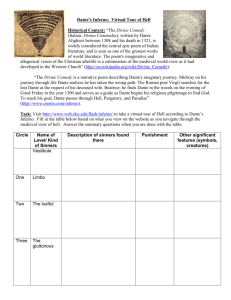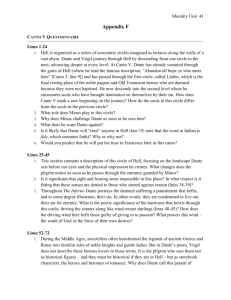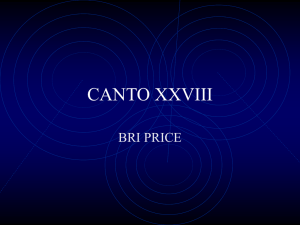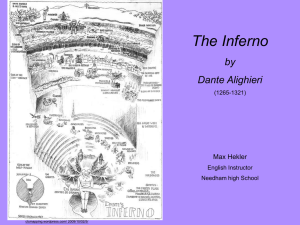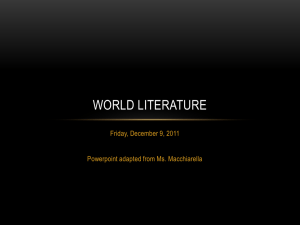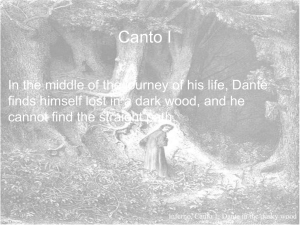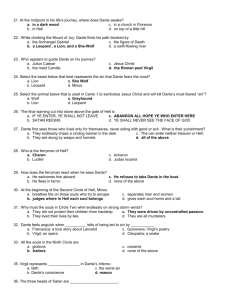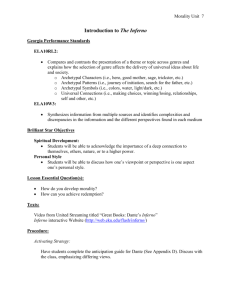Illuminating Botticelli's Chart of Hell
advertisement
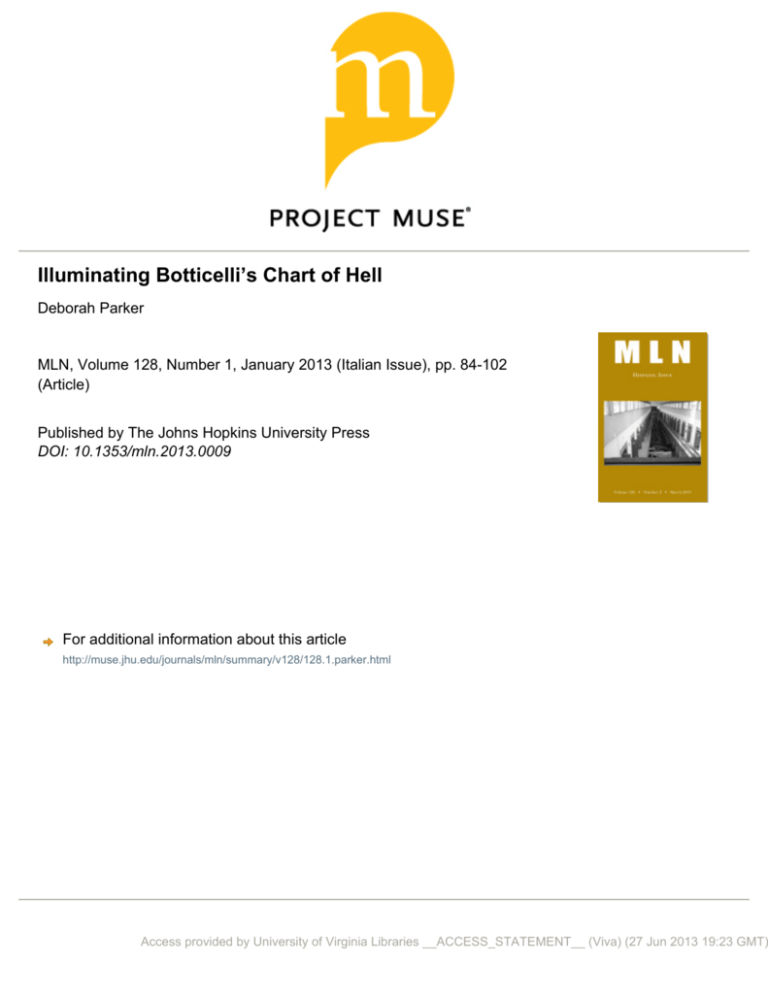
Illuminating Botticelli’s Chart of Hell Deborah Parker MLN, Volume 128, Number 1, January 2013 (Italian Issue), pp. 84-102 (Article) Published by The Johns Hopkins University Press DOI: 10.1353/mln.2013.0009 For additional information about this article http://muse.jhu.edu/journals/mln/summary/v128/128.1.parker.html Access provided by University of Virginia Libraries __ACCESS_STATEMENT__ (Viva) (27 Jun 2013 19:23 GMT) Illuminating Botticelli’s Chart of Hell ❦ Deborah Parker Botticelli’s Chart of Hell (c.1485–c.1500) has long been lauded as one of the most compelling visual representations of Dante’s Inferno. The chart is one of ninety illustrations which the artist (1445–1510) executed for a lavish codex of the Commedia commissioned by Lorenzo di Pierfrancesco de’ Medici, the cousin and ward of Lorenzo de’ Medici. Botticelli likely began work on the Dante illustrations in the mid-1480s and finished them in the mid-1490s. Executed during a period of considerable interest in infernal cartography, Botticelli’s Chart of Hell furnishes a panoptic display of the descent made by Dante and Virgil through the “abysmal valley of pain” (Inf.4.8).1 Notwithstanding the comprehensive nature of this representation of the Inferno, it has been difficult for scholars to assess its full intricacy due to the minute scale of the individual motifs. The original drawing measures 32.5 cm x 47.5 cm. The small figures in the original measure less than one centimeter. Reproductions are often smaller, compounding this difficulty. Most of the critical discussion has focused on the artist’s illustrations of the individual cantos. Kenneth Clark, Peter Brieger, Millard Meiss, and Charles Singleton have clarified the relationship of Botticelli’s illustrations to earlier and later manuscript I am indebted to Ricardo Padron, Tom Conley, and Ted Cachey for their comments on an earlier version of this study that was delivered as a talk at the Renaissance Society of America in 2009. I would like to thank Mark Parker, Paul Barolsky, Caroline Elam, and Jonathan Nelson for their comments on an earlier draft of this essay. 1 All citations from the Inferno are to the following edition: The Divine Comedy of Dante Alighieri: Inferno, trans. Allen Mandelbaum (New York: Bantam, 1980, rpt. 2004). MLN 128 (2013): 84–102 © 2013 by The Johns Hopkins University Press M L N 85 Fig. 1. Botticelli, Chart of Hell, c.1480–c.1495. Vat. Lat. 1896. Biblioteca Apostolica Vaticana. illuminations representations of the Inferno.2 More recently, Peter Dreyer, Barbara Watts and the contributors to the 2000–2001 exhibition of Botticelli’s illustrations to the Commedia have added considerably to our understanding of the intricacies found in the illustrations to the individual cantos. Less attention, however, has been paid to the ways in which the map of Hell represents an ingenious interpolation of the first canticle. One can read the map as one does the poem albeit in a distinctly different way. This essay seeks to provide a different perspective on the map, one that explores Botticelli’s visual remediation of a complex poetic narrative and how the artist literalizes that which is allusive.3 2 Kenneth Clark, The Drawings of Sandro Botticelli for Dante’s Divine Comedy: after the originals in the Berlin Museums and the Vatican (New York: Harper & Row, 1976); Peter H. Brieger, Millard Meiss, and Charles S. Singleton, Illuminated Manuscripts of the Divine Comedy (Princeton: Princeton UP, 1969). 3 I employ remediation throughout this article along the terms discussed in Jay Bolter and Richard Grusin, Remediation: Understanding New Media (Cambridge, MA: The MIT Press, 1999). The two authors declare: “we call the representation of one medium in another remediation, and we will argue that remediation is the defining characteristic of new media” (45). Remediation transpires at different intensities and with different attitudes toward the earlier medium. It can be reverential, simply re-presenting an 86 Deborah Parker My interest in the chart was itself prompted by another act of remediation. I am the editor of The World of Dante (www.worldofdante.org), a multimedia digital archive created for researching and teaching the Divine Comedy. One of the components of the site is a digitized image of the Chart of Hell. My collaborators at IATH (Institute for Advanced Technologies in the Humanities) created a digital image of the map from a large color transparency that we had obtained through the Vatican Library.4 As my colleagues and I thought through the digital representation of Botticelli’s map, it led me to a reconsideration of the artist’s own act of remediation—his presentation of Dante’s poetic work in a visual medium. The magnification enabled through digitization proved especially propitious and illuminating. Most importantly, the version of the map on The World of Dante allows viewers to scrutinize and identify details scarcely discernible in the original easily and appreciate more fully the way in which the chart furnishes a canny assimilation of Dante’s narrative. Botticelli does not simply demonstrate his extensive knowledge of the first canticle—a fact that has been frequently observed—he invests the map with stories, creating in the process an encapsulation of the entire journey. Through the Chart of Hell the well-informed reader can approach the poem in an alternative manner, savoring stages of the voyage through an intricate panoramic display. In the Chart of Hell Botticelli spatializes and adapts what is essentially a temporal experience, namely the reading of poetry. In following Botticelli’s movement from word to image, we can better understand both the constraints and the serendipitous grace involved in such artistic transactions. In what follows I will first clarify the number of episodes earlier medium, and in the process rendering itself transparent, or it can be quite hostile, seeking to obliterate the predecessor. In Botticelli’s case the remediation of Dante’s poem is reverential. My interest lies in exploring how this visual remediation changes the position of the viewer/reader. 4 Ultimately we decided to furnish a more informative version of the map for The World of Dante. We created two ways of viewing the map: scholars can study Botticelli’s map on their own using Zoomify to enlarge areas they would like to scrutinize or examine it through a transparent layer that we have added. This second layer allows viewers the opportunity to select specific circles, rivers, or regions of Hell (all of which are now labeled), follow the trajectory of Dante and Virgil’s descent, and see close-ups of the two wayfarers. The colors in this version are more saturated than those found in reproductions of the map and reflect those on the transparency given us by the Vatican Library. While a magnifying glass would allow something of the same effect as magnification through digitization, viewing the map with a magnifying glass tends to compartmentalize the image more. Zoomify allows for a smoother viewing of the magnified image. While the digital version allows us to enlarge the map, it goes without saying that digital surrogates do not eliminate the need to consult the original document. M L N 87 from the Inferno that Botticelli has illustrated, then explore how the artist achieves the effect of an ongoing narrative before examining finally how he portrays aspects of Hell’s topography and the voyage not mentioned by Dante Recent studies of the map by Peter Dreyer, Barbara Watts, and Giovanni Morello have clarified the Chart’s relation to the manuscript tradition, to Baccio Baldini’s engravings to the 1481 edition of the poem with a commentary by Cristoforo Landino (1424–1498), and to depictions such as Nardo di Cione’s fresco of Hell in the Strozzi Chapel in Santa Maria Novella in Florence (Botticelli based the engravings in the 1481 Landino Dante on his earlier drawings.) Earlier representations of Dante’s Inferno were neither as comprehensive nor as detailed as that of Botticelli. Nardo’s fresco of 1354–57 renders Hell as a series of stratified layers. The artist confines himself to representing the punishments and some of the landscape of Hell. Rather than locating the nine circles below one another, Nardo places the first five circles of Hell adjacent to one another: the Lustful are depicted next to the Gluttons, the Avaricious and Prodigal next to the Wrathful. Similarly, all three rings of the seventh circle of the Violent are placed next to one another. The focus is on the punishments: Dante and Virgil do not appear anywhere in this rendition.5 Botticelli’s Chart differs notably from Nardo’s work, most notably in the shape accorded Hell, the number of episodes depicted, and the inclusion of the two wayfarers. The precision with which Botticelli has rendered various stages of the voyage merits particular attention. From Dante and Virgil’s momentous passage through the Gate of Hell to their dramatic exit, Botticelli illustrates more than fifty passages from the poem. Many of the encounters with demons and souls are portrayed. A comparison of the chart to the individual cantos reveals a high degree of consistency suggesting that the chart was executed after the illustrations had been completed. The only time the two wayfarers are not shown on the Chart is in Malebolge, a section of the map simply too small to allow the inclusion of their movements. The artist’s sources for the chart extend beyond sources adapted from the miniatures of the manuscript tradition. Botticelli incorporates details culled from Antonio du Tuccio Manetti’s (1403–97) observa5 For an example of a depiction of Dante’s Inferno which does feature occasional representations of the two travelers, typically in colloquy with one another, see the reproduction of Bartolomeo di Fuorsino’s illustration in Illuminated Manuscripts of the Divine Comedy, eds. Peter Brieger, Millard Meiss, and Charles S. Singleton, 2 vols. (Princeton: Princeton UP, 1969) 2.31. 88 Deborah Parker Fig. 2. Nardo di Cione, Hell, 1354–7. Strozzi Chapel, Santa Maria Novella, Florence. tions concerning the Inferno’s cartography in his rendition. Manetti’s ideas are posthumously outlined in Girolamo Benivieni’s Dialogo di Antonio Manetti (1506).6 Far more comprehensive than the synopsis of Manetti’s calculations published in Landino’s 1481 commentary, the Dialogo posits an extended conversation between Benivieni and Manetti on the “site, form, and measurements of Hell.” Basing his 6 I am indebted to Ted Cachey for the reference to Manetti’s role in the Benivieni dialogue. For the text of the dialogue, which was published at the end of his 1506 Giuntine edition of the poem, see Hieronymo Benivieni, Dialogo di Antonio Manetti,Cittadino Fiorentino Circa al sito, forma et misure dello Inferno di Dante Alighieri, ed. Nicola Zingarelli (Città di Castello: Lapi, 1807) 44–45, 65, 87, 104, 109. For discussions of the popularity of discussions of Hell’s topography in the late Quattrocento and early Cinquecento, see John Kleiner, Mismapping the Underworld. Daring and Error in Dante’s Comedy (Stanford, CA: Stanford UP, 1994). M L N 89 computations on Dante’s mention that the last ditch of Malebolge measures half the circumference of the previous one (eleven miles rather than twenty-two), Manetti estimates the width of Limbo as 87 ½ miles. On the Chart the circumference of the first five circles of Hell is notably greater than the dimensions of Malebolge. Botticelli also follows Manetti in his portrayal of other particulars. Dante encounters the Neutrals or Pusillanimous souls in the vestibule of Hell after passing through the Gate of Hell. In Benivieni’s Dialogo Manetti describes the place as “una grandissima cauerna tra la superficie dello aggregato et el fiume di Acheronte” (“an enormous cavern between the surface of the aggregate and the Acheron River”).7 Botticelli follows Manetti both in installing the Neutrals in a cavern on the Chart and portraying Upper Hell as an amphitheater. Manetti’s observations also likely inspired Botticelli’s decision to depict the well of the giants as rising perpendicular from Cocytus and the depiction of Satan surrounded by a round sphere of ice. In his commentary Landino does not comment on these particulars.8 Taken together these details show that Botticelli had not only assimilated earlier manuscript illustrations and the particulars of Dante’s text, but also contemporary critical observations about Hell’s cartography.9 In this respect the Chart of Hell furnishes a particularly Florentine interpretation of Hell’s topography. Such obsessive detail was not always appreciated. Vasari chides Botticelli for having “wasted much of his time, bringing infinite disorder to his life” in devoting so much time to studying Dante, but such assiduous attention is not without considerable merit.10 The Chart Benivieni, Dialogo 104. For Landino’s synopsis of Manetti’s mathematical calculations on the dimensions and form of the Inferno, see Cristoforo Landino, Comento sopra la Comedia, ed. Paolo Procaccioli, 4 vols. (Rome: Salerno, 2001)1.270–78. Landino makes no mention of any cavern in his discussion of the Neutrals nor does he comment on shape of the well of the giants. In his illustration to Inf.34 Botticelli draws a circle around the middle of Satan’s body that is clearly intended to represent the lake of ice that surrounds him and which is visible on the Chart. 9 It is possible that Botticelli learned of Manetti’s ideas from personal acquaintance. Herbert Horne discovered in a ricordo of Manetti, he copied a letter of Simone di Mariano Botticelli, the artist’s brother. See Herbert P Horne, Botticelli Painter of Florence (London, 1908, reprinted Princeton: Princeton UP, 1980) 271. Given that he illustrated Landino’s 1481 Dante, he would have been familiar with Landino’s synopsis of Manetti’s calculations on the dimensions of the Inferno. 10 Giorgio Vasari, “Sandro Botticelli,” Lives of the Painters, Sculptors and Architects, trans. Gaston du C. de Vere, 2 vols. (New York: Alfred A. Knopf, 1996)1:538. For the Italian text, Giorgio Vasari, Le vite dei più eccellenti pittori, scultori e architetti, ed. Paola Della Pergola, Luigi Grassi and Giovanni Previtali (Novara Istituto Geografico de Agostini Rome: Newton Compton, (1996 ) 3.198–99 in which Vasari notes “e figurò lo inferno e lo mise in stampa, dietro al quale consumò di molto tempo, per il che non lavorando fu cagione di infiniti disordini alla vita sua.” 7 8 90 Deborah Parker of Hell attests to an astonishing familiarity with the poem. Appendix 1 shows my estimation of the passages of the poem depicted on the Chart. Beginning with the opening of Inf. 3, where Dante reads the inscription over Hell’s gate, Botticelli illustrates in succession Dante’s and Virgil’s encounters with the presiding demons and souls found among the Virtuous Pagans, the Lustful, the Avaricious and Prodigal and the Wrathful. Among the latter group we see Phlegyas transporting Dante and Virgil to the gates of Dis, the arrival of the two travelers in Lower Hell, and their entry into the sixth circle of the heretics. The painter illustrates all three rings of the seventh circle of the violent; the bloody waterfall which runs into Malebolge; the punishment of the Usurers; Geryon flying Dante and Virgil to the top of Malebolge; the punishments of the fraudulent sinners in the ten divisions of Malebolge; the Giants, including the episode of Antaeus lowering Dante and Virgil down to Cocytus; the punishment of the Traitors, replete with a detail of Alessandro and Napoleone degli Alberti (an instance of fratricide among the traitors), Satan, and finally Dante and Virgil climbing down Satan’s body. Botticelli does not confine himself to depicting the major divisions of Hell as one typically finds in Renaissance or modern maps of Dante’s Hell; he takes pains to depict all the punishments described as well as Dante’s and Virgil’s successive meetings with sinners or demons within a particular circle. Such moments are especially apparent in Botticelli’s depiction of the first five circles of Hell. This remarkable attention to detail is extended to the depiction of Hell’s topography and architecture. We see, for example, the seven walls surrounding the castle of Limbo. The Chart even shows vestiges of the earthquake caused by the Harrowing of Hell: the artist has meticulously depicted the mass of tumbled rocks outside the tomb of Anastasius II and the broken ridge over the bolgia of the Hypocrites in Malebolge. The precision extends to Malebolge itself where we can see minutely rendered particulars such as the crucifixion of the arch-hypocrite Caiaphas, a reptilian monster attacking the thief Vanni Fucci, and a decapitated Bertran de Born, the Provençal poet who sowed discord between Henry I and his son. The inclusion of such details shows not only the comprehensive nature of this pictorial adaptation of Hell, it attests to Botticelli’s skill as a draughtsman. The Dante drawings were initially incised with a blind stylus into the parchment, and then overdrawn with a lead-tin stylus that leaves a grey line. The artist subsequently went over these drawings with brown iron-gall ink before painting in the colors with the kind of tempera pigments used by manuscript illuminators. The gilded border constitutes one of the most striking features of the Chart of Hell: it creates an illusionistic effect, producing essentially the look M L N 91 of a gilded frame on a painting.11 As the most completely colored work of the Dante illustrations, the details depicted in Malebolge exemplify the painstaking care with which Botticelli executed this illustration.12 One of the most distinctive features of the Chart of Hell is Botticelli’s insistent focus on the progress of Dante and Virgil through the abyss: the two wayfarers appear no less than twenty-seven times. As in the detailed illustrations to the cantos, Dante is attired in a scholar’s cap and sleeveless lucco, a loose-fitting tunic worn by persons of different ranks over a green long-sleeved cassock; Virgil wears a blue long-sleeved undergarment, a purple sleeveless over garment and a taller cone-shaped hat. Whereas some earlier manuscripts tend to show him garbed in blue, in the chart Dante wears red, possibly following a Florentine tradition. From the portrait of the poet attributed to the school of Giotto in the Bargello’s Capella della Maddalena to Domenico di Michelino’s Dante Reading from the Divine Comedy in Florence’s Duomo, Dante is consistently shown in a red garment.13 Without the multiple portrayals of the two wayfarers, we would be left with a static cross-section of Hell. In portraying the trajectory of their descent, however, Botticelli creates two unique perspectives: if we examine the map from top to bottom, we can follow the progression of Dante’s and Virgil’s journey, which in turn follows Dante’s narrative. If, on the other hand, we look at the map all at once we have the impression of viewing the entire journey simultaneously. Botticelli effectively transforms the linear experience of reading the poem into a panoptic display. Botticelli’s pictorial narrative differs from the poetic one in an important way: there is no distinction between Dante the poet and Dante the pilgrim. On the Chart of Hell Dante is objectified, forming an indivisible unit with his guide Virgil. Indeed one might easily conclude that Virgil is the more prominent figure: if one looks closely at each of the depictions, we see that Dante is almost always behind Virgil, who is often pointing out something to his charge. In portray- 11 I am indebted to Caroline Elam for the information on Botticelli’s technique of illustration and the depiction of the illusionistic gilded border. 12 On this point see Charles Dempsey, “Botticelli, Sandro,” Encyclopedia of Italian Renaissance and Mannerist Art, ed. Jane Turner, 2 vols. (London: Macmillan Reference Limited, 2000) 1.246. For a detailed discussion of the artist’s drawing techniques in the Dante illustrations, see Doris Oltrogge, Robert Fuchs, and Olivia Hahn, “Finito and Non finito Techniques in Botticelli’s Divine Comedy, in Sandro Botticelli,” The Drawings for Dante’s Divine Comedy (London: Royal Academy of Arts, 2000): 334–41. 13 For an excellent overview of Renaissance portraits of Dante, see Jonathan Nelson, “Dante Portraits in Sixteenth-Century Florence,” Gazette des Beaux-Arts (1992):59–77. 92 Deborah Parker ing the two travelers together, the chart elides the difference between the poet who narrates the story of his journey and the pilgrim who experiences it. The map begins with Inf.3 and the inscription over the Gate of Hell. Interestingly, Botticelli has not portrayed Dante’s dark night of the soul in the dark wood, the subject of the first two cantos. This decision further occludes the centrality of Dante the poet. In this encyclopedic rendering, the dramas of individuals, including those of the poet, are subsumed to the greater interest of portraying the grand design of Hell. Botticelli’s objective, however, was not the portrayal of the poet/ pilgrim distinction. The artist seeks to convey the continuum of narrative in his numerous depictions of Dante and Virgil. Art historians have noted the artist’s interest in portraying different moments of a story, a convention derived from fourteenth-century art and evidenced in the Moses frescoes in the Sistine Chapel, the four panels of the Life and Miracles of St. Zenobius, and the spalliere paintings devoted to the Story of Virginia, the Story of Lucretia, and Boccaccio’s eerie tale of Nastagio degli Onesti. The Moses and Nastagio paintings, completed before Botticelli undertook the Dante commission, and the Virginia and Lucretia paintings, executed in the 1490s, portray different scenes of a narrative both within a single panel and across different panels. 14 We can best appreciate the way in which Botticelli portrays narrative progression by examining his depiction of specific circles of Hell. In his rendition of Limbo, Botticelli illustrates four of the incidents recounted in Inf.4: we see Virgil, Lucan, Homer, Ovid and Horace standing before a fire, pausing at the entrance to the castle, traversing a green meadow within the castle’s walls, and paying tribute to Dante. As Dante reports, the “bella scola” (“splendid school”) of pagan poets claim him as one of their own, declaring him “sesto fra cotanto senno,” (“sixth among such intellects”; Inf.4.102), a detail which Botticelli artfully heightens by elevating Dante above the other five poets—exaggerating in so doing Dante’s claim of equality. Botticelli also portrays multiple episodes recounted in the meeting with the Lustful: we see Dante and Virgil before Minos, their observation that the “bufera infernal” (“hellish hurricane”; Inf.5.31) that batters the Lustful, Dante speaking to Paolo and Francesca, and finally the pilgrim’s swoon upon hearing her doleful tale. Botticelli’s treatment of Geryon also shows his interest in portraying the progressive stages 14 For an excellent discussion of the way in which Botticelli portrays narrative in the Nastagio degli Onesti panels, see Christina Olsen, “Gross Expenditure: Botticelli’s Nastagio degli Onesti Panels,” Art History 15 (1992):146–70. M L N 93 Fig. 3. Botticelli, Detail of Limbo, Chart of Hell, World of Dante. of the journey: the two poets are first portrayed atop the beast, then at the top of the eighth circle from which they survey Malebolge. Since Botticelli’s illustrations of Inf. 1–7 are no longer extant, it is not possible to compare the depictions of Limbo and the Lustful on the Chart to his treatment of these cantos, but we can compare his treatment of Geryon. A detail from the drawing that accompanies Inf.17 shows shows the painter’s interest in rendering sequential moments of narration, which is even more evident in the individual drawings. In both the Chart of Hell and the illustrations for the individual canti, Botticelli takes pains to render successive events, essentially spatializing the temporal experience of reading Dante’s narrative. Rather than reading down the page of the manuscript, the viewer “reads” the trajectory of the voyage as Botticelli portrays it. What I have called the spatialization of poetry is most evident in details that Botticelli adds to the Chart. Botticelli takes into account what is not explicitly recorded by Dante but can be inferred from the poem. His depiction of the scene at the river Acheron exemplifies this tendency. Whereas Dante describes the misery of the recently arrived damned souls and compares their descent into Charon’s boat to falling leaves (itself a Virgilian simile), Botticelli shows what happens after the damned tumble into Charon’s boat, namely their transport across the Acheron. Botticelli’s portrayal of Charon, on the other hand, illuminates another canny interpretation of what Dante’s 94 Deborah Parker Fig. 4. Botticelli, Detail of Geryon, Chart of Hell, World of Dante. Fig. 5. Botticelli, Detail of Inf.17, c.1480–c.1495, Drawings for Dante’s Divine Comedy, Kupferstichkabinett, Berlin. M L N 95 words suggest. Dante describes the ferryman as “Caron demonio, con occhi di braga” (“The demon Charon, with his eyes like embers”; Inf.3.109). While Dante designates the ferryman as a demon, he makes no mention of demonic attributes, singling out for mention only his hoary cheeks (“lanose gote”) and fiery orbs. Dante’s characterization is economical, the details carefully condensed. Botticelli depicts the ferryman as a winged demon, giving him a more explicitly diabolical appearance than Dante’s Charon. In this detail, Botticelli follows depictions of Charon discernible in other manuscripts: Cristoforo Cortese also depicts Charon with wings in a manuscript dated to the first half of the fifteenth century.15 This enhancement is more than an imaginative interpolation of the poetic text. In portraying Charon with wings, Cortese and Botticelli link the ferryman to the other demonic guardians who preside over circles two through five and to the devils that populate Dis and Malebolge.16 Such additions not only renders the patterns extant in Dante’s poem, they suggests new ones. Other interpretations are evident in Botticelli’s depiction of Limbo. For example, Dante describes the verdant landscape and “nobile castello” toward which Dante walks with the luminaries of the “bella scola.” Botticelli embellishes the allusion to the seven walls that surround the castle by adding seven towers. Possibly a symbol of the seven liberal arts, the addition of seven towers underscores the distinctive nature of the castle and its inhabitants within the landscape of Limbo. Earlier manuscript illustrations usually show only one tower. Although Dante does not describe the landscape of Limbo aside from the area around the castle, Botticelli creates his own topography, portraying the area outside the castle as a barren landscape and in so doing makes the landscape of the first circle consistent with that of the rest of the Inferno. As in his portrayal of Charon, the artist furnishes details not provided by the poet. Where Dante condenses, Botticelli here expands. At once we sense how fortunate these noble souls are, as we grasp their splendid isolation amid a landscape of death, despair, and suffering. Botticelli’s treatment provides an emphatic contextualization for the Virtuous Pagans—the afterlife as a limited respite from pain, not the full glory of Paradise. We find another canny inference in the artist’s depiction of the Usurers. While the Usurers are punished in the burning plain along with See Illuminated Manuscripts 2.64. It is worth noting that the illustration attributed to Giuliano di Sangallo by Dreyer also shows Charon with wings. Hence Botticelli and the artist of this drawing are likely following earlier depictions of Charon with wings in illuminated manuscripts. This drawing also includes one set of stairs and shows Satan surrounded by a circular lake of ice. 15 16 96 Deborah Parker Fig. 6. Botticelli, Detail of Charon, Chart of Hell, World of Dante. the Sodomites and Blasphemers, Dante postpones his encounter with them until the middle of Inf.17, inserting the pilgrim’s description of the misery of the Usurers between the introduction of Geryon and the flight to the eighth circle. In his commentary Landino merely notes that the Usurers are “su l’orlo al septimo cerchio” (“on the edge of the seventh circle”).17 Botticelli, however, captures this separation in a distinct and subtle way: he places the Usurers below the Sodomites and Blasphemers (see fig.4). Their positioning captures Dante’s separation of the Usurers from the other violent souls brilliantly. The artist follows the same procedure in his illustration to this canto: here the precipice drops off even more sharply allowing the artist to show the Usurers sitting on the ledge below the Sodomites running above.18 In both the Chart and the illustration to Inf.17 Botticelli’s ingenious objectification of the poem enforces a clarification of space that Dante’s subjective narrative need not follow. One of Botticelli’s most notable visual interpolations is the inclusion of stairways between the vestibule and Limbo, the third and fourth circles (Gluttons and the Avaricious and Prodigal), and between the fourth and fifth circles (Avaricious and Prodigal and the Wrathful) (see fig.4). At no point in the Inferno does Dante explain how the two wayfarers descend from one circle to the next. Upon seeing a rivulet Landino 2.724. Other manuscript illustrators tend to show the usurers on the same plane as Dante and Virgil. See Illuminated Manuscripts 2.197. 17 18 M L N 97 of the Phlegethon after the two had crossed the river two cantos earlier, Virgil describes their descent in very general terms: “Tu sai che ’l loco è tondo; / e tutto che sie venuto molto, / pur a sinistra. giù calando al fondo” (“You know that this place is round; / and though the way you have come is long, and always to the left and toward the bottom”; Inf.14.124–26). Once they have climbed onto Geryon’s back, Virgil declares: “Omai si scende per sì fatte scale” (“our descent is by this kind of stairs”; Inf.17.82). “Scale,” however, is employed metaphorically in this passage, as elsewhere, where Virgil refers to Satan’s body as “scale,” the means by which the two pilgrims will exit Hell (Inf.34.82). For Botticelli, on the other hand, the stairways are not symbolic but functional and concrete: they indicate how Dante and Virgil make their way from one circle to another. Such additions constitute a distinctly visual reading of the poem, showing readers not simply what the pilgrim saw but also what Dante does not describe.19 Such features of the Chart of Hell suggest how Botticelli has adapted the script put forth by Dante. Ultimately, the stairways furnish a particularly visual resolution to the absence of any information concerning the means by which Dante and Virgil make their way from one circle to another. The challenge for the artist is to render the descent through Hell in a coherent way. To this end Botticelli literalizes that which is allusive, concentrated, or metaphoric in Dante, explicitly providing details not furnished in the narrative. We might ask ourselves at this point what is the difference between reading Dante’s poem and viewing Botticelli’s Chart of Hell. How does the eye move through Botticelli’s map? What achieves new prominence in viewing the map as opposed to reading the poem? First of all the artist’s remediation of the Inferno changes the subject position of the reader/viewer: whereas reading is a linear temporal process with a sharply defined and delimited focus, the experience of viewing the map is by turns more diffuse and more fragmented. Although one might study the chart progressively from top to bottom, the minuteness of the details makes this difficult. The viewer’s eye tends to move between individual detail and the overall structure of Hell. What we might call the work of reading—the recollection 19 Watts 176. In another article Watts notes that Botticelli renders Dante’s geography more exact in Purgatory. For example, the artist portrays Dante’s and Virgil’s progress through “quella cruna” (“needle’s eye”) of Purg.10.16, a narrow opening in the rock of mountain of Purgatory by showing the poets’ progress through a narrow opening of stone. See Barbara J. Watts, “Artistic Competition, Hubris, and Humility: Sandro Botticelli’s Response to Visibile Parlare,” Dante Studies 114 (1996):44. 98 Deborah Parker of past events and the anticipation of future incident—is here made manifest and inescapable. In this sense the Chart of Hell furnishes a visual index or synopsis to which readers might refer as they read the Inferno. What Dante’s reader, and, at times, Dante’s pilgrim, can forget in the immediacy of the moment, Botticelli’s viewer can never really evade in this visual synopsis. While there is no obvious center of focus, every place in Hell is always contextualized. Every encounter with a demon or soul is seen in terms of the overall structure of Hell. As a result, momentous encounters such as Dante’s meetings with Paolo and Francesca, Farinata, Pier della Vigna, or Ugolino become small details in the larger representation of damnation. Propinquity and intimacy give way to panoptic display; detail is subordinated to structure; human emotions are subsumed to the divine design of Hell. These details, in turn, are given their due in the detailed drawings to the cantos. It is worth noting that Dante provides his own “chart of Hell” in Inf. 11. As the two wayfarers accustom themselves to the stench of Lower Hell, Virgil takes the opportunity to explain the division of sins in the Inferno by describing the sins of violence and fraud whose inhabitants are punished in the seventh and eighth circles: “My son, within this ring of broken rocks,” he then began, “there are three smaller circles; like those that you are leaving, they range down. Those circles are all full of cursed spirits; so that your seeing of them may suffice, learn the how and why of their confinement. Of every malice that earns hate in Heaven, Injustice is the end; and each such end by force or fraud brings harm to other men. However, fraud is man’s peculiar vice; God finds it more displeasing—and therefore, The fraudulent are lower, suffering more. The violent take all of the first circle; but since one uses force against three persons, that circle’s built of three divided rings. To God and to one’s self and to one’s neighbor— I mean, to them or what is theirs—one can Do violence, as you shall now hear clearly [ . . . ]” (Inf.11.16–33) Explicating prosaically matters such as the three main categories of sin (incontinence, violence and fraud), what transgressions are punished in each division, and the difference between fraud and treachery, Dante renders into poetry Aristotelian ideas on malice and the dispositions M L N 99 of the soul that Heaven opposes. This canto, interestingly enough, has won little praise among critics and readers. Often facetiously dubbed a “filler” by critics, Inf.11 is unremittingly methodical. As Robert Hollander puts it: “this canto is not nearly as exciting as those that have gone before (and those that will come after), since it involves nothing but pedantic lecturing.”20 Nevertheless, Inf.11 provides us with a moment in which Dante’s temporal perspective becomes spatial. As such, this account of the overall scheme of Hell furnishes a revealing point of comparison with Botticelli’s panoptic display, ultimately affording an opportunity to examine the way in which the artist’s visual embodiment of the narrative affects fruition. In a sense the viewer of the Chart of Hell is in the same position as the reader of Inf.11: whether studying the chart or reading this canto, the overall structure of the “blind prison” is always apparent. Botticelli’s remediation of the poem, his representation of the entire journey in all its simultaneity, changes the subject position of the reader/viewer significantly. To see this difference one need only compare the experience of reading of Inf.10 to Inf.11. The pilgrim’s highly dramatic encounter with Farinata throws us inside the volatile world of Florentine politics. Dante is initially daunted as he stands before Farinata, who rises imperiously from his sepulcher, “com’avesse l’inferno a gran dispitto” (“as if he had tremendous scorn of Hell”; Inf.10.36). It is not Farinata’s place in the larger scheme of punishment and damnation that is foremost here; it is the tension between him and Dante, which arises both from personal relations and political commitment that animates this scene. In listening to Virgil’s explanation of the divisions of Hell and disposition of its inhabitants in Inf.11, however, individuality is subordinated. It is as if we are looking at ants from a great height: we see the mass not the individual. Whereas Dante’s textualized account of space in Inf.11 has its longuers, Botticelli’s readable map is marvelously engaging. While the intricacy of the map would impress any viewer, the painstaking rendering of so many moments from the Infernal voyage offers something akin to a wunderkammer for readers with a profound knowledge of the first canticle. Ultimately, viewing the Chart of Hell becomes an act of memory, as its wondrous particulars take the reader/viewer back to the original through artful remediation. Botticelli’s visual embodiment of the Inferno is not transparent. The artist intervenes 20 Dante Alighieri, Inferno, trans. Robert and Jean Hollander (New York: Doubleday, 2000)194. 100 Deborah Parker in his remediation to put his own stamp on the infernal journey and Dante’s role in it. If reading the poem places us inside the narrative, the Chart of Hell shifts our mode of entry into this work from inside to outside. The artist has brilliantly memorialized not simply Dante’s poem but Florentine culture in adapting contemporary discussions of Hell’s topography. The Chart effectively takes us from the personal to the public sphere, from a subjective to objective perspective, from Dante’s vision to a cultural view of his great achievement. What we see, then, in this comparison between poem and chart, between word and image, is a particular kind of incommensurability. Dante’s commitments to the temporal, the narrative, and the progressive experience of reading produce a complexity of character and immediacy of appeal. We are most dramatically in the moment. Botticelli’s representation foregrounds the spatial, a decision which has the effect of flattening encounters with different characters by showing us the context for each sin. The poem’s psychology and plot give way to the chart’s timeless qualities of structure. If Dante’s account of the illusionistic sculptures in Purgatory constitutes an encomium to the verisimilitude of great art, memorably described as “visibile parlare,” (Purg.10.95) Botticelli has furnished us with an eminently readable image—“legibile dipingere”—something which comes as no surprise from an artist whom Vasari aptly described as a “persona sofistica.”21 University of Virginia APPENDIX 1 Passages from the Inferno Depicted on Botticelli’s Chart of Hell Inf.3.1–9: Dante and Virgil read inscription over the Gate of Hell Inf.3.55–57: Neutrals chasing a banner Inf.3.70–72: Damned before Charon’s boat Inf.3.78: Acheron Inf.3.82: Charon 21 Vasari, Le vite dei più eccellenti pittori 3.198. For an intriguing discussion of how Botticelli’s illustrations to Purg.10, which are strikingly illusionistic in their use of perspective to portray a three dimensional sense of space, might constitute a response to Dante’s claim that human art cannot hope to match the realism of God’s art, see Watts, “Artistic Competition.” See also Barbara Watts, “The Word Imaged: Dante’s Commedia and Sandro Botticelli’s San Barnaba Altarpiece,” Lectura Dantis: Visibile Parlare. Dante and the Art of the Italian Renaissance, ed. Deborah Parker (1998):203–46. M L N 101 Inf.4.68: Dante and Virgil before a fire with Lucan, Homer, Ovid, Horace Inf.4.106: The six poets at entrance of the castle Inf.4.111: The six poets converse on a meadow inside the castle Inf.5.4: Dante and Virgil before Minos Inf.5.31–33: Punishment of the Lustful Inf.5.74: Dante and Virgil speaking to Paolo and Francesca Inf.5.142: Dante’s swoon Inf.6.13–15: Dante and Virgil before Cerberus Inf.6.19–21: Punishment of the Gluttons Inf.6.38: Dante and Virgil speaking to Ciacco Inf.7.4: Dante and Virgil before Plutus Inf.7.25–27: Punishment of the Avaricious and Prodigal Inf.7.100–03: Descent to Styx Inf.7.112–20: Punishment of the Wrathful and Sullen Inf.8.16–17: Phlegyas in his boat Inf.8.76–81: Phlegyas leaves Dante and Virgil at the Gates of Dis Inf.9.121–23: Punishment of the Heretics Inf.11.2: Mass of toppled rock caused by Harrowing of Hell Inf.11.7–9: Tomb of Anastasius II Inf.12.47: Phlegethon Inf.12.52–57: Punishment of the Murderers, Plunderers, and Tyrants Inf.13.4–6: Wood of the Suicides Inf.14.19–24: Punishment of the Blasphemers and Sodomites Inf.16.103–05: Bloody waterfall Inf.17.31–36: Punishment of the Usurers Inf.17.115–17: Geryon flying Dante and Virgil to the top of the eighth Circle Inf.17.43–44: Dante observes the Usurers Inf.18.1–21: Dante and Virgil survey Malebolge Inf.18.34–36: Punishment of the Panderers and Seducers Inf.18.112–14: Punishment of the Flatterers Inf.19.22–24: Punishment of the Simonists Inf.20.10–15: Punishment of the Diviners Inf.21.19–21: Punishment of the Barrators Inf.21.106–08: Broken bridge over the sixth bolgia (Hypocrites) Inf.23.58–63: Punishment of the Hypocrites Inf.23.115–23: Punishment of arch-hypocrites (Caiaphas and other Pharisees) Inf.24.91–96: Punishment of the thieves, including Vanni Fucci (shown seated on the left attacked by snakes) Inf.26.40–41: Punishment of the False Counselors 102 Deborah Parker Inf.28.38–42: Punishment of the Sowers of discord Inf.29.46–51: 67–69: Punishment of the Falsifiers Inf.31.31–33: Giants Inf.31.70–78: Nimrod with his horn Inf.31.115–29: Virgil addressing Antaeus Inf.31.142–43: Antaeus lowering Dante and Virgil to Cocytus Inf.32.22–23: Cocytus Inf.34.11–15: Punishment of the traitors frozen in Cocytus, including Alessandro and Napoleone degli Alberti (two souls shown together) Inf.34.53–57: Satan gnawing on Judas, Brutus and Cassius

